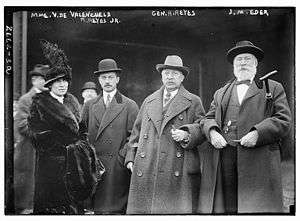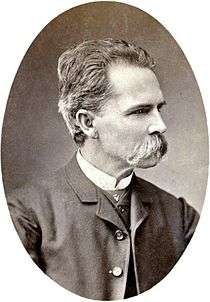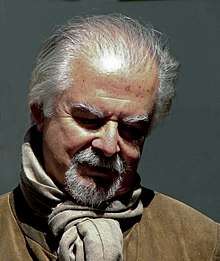White Colombians
| Total population | |
|---|---|
|
approx. 17,519,500 (37% of the Population[1]) | |
| Regions with significant populations | |
| Throughout the nation, especially in the Andean Region and the major cities. | |
| Languages | |
|
Predominantly Colombian Spanish (Spanish · Italian · Basque · German · French and some other languages are spoken by minorities) | |
| Religion | |
| Predominantly Christianity (Roman Catholic, Protestant, other Christians), Atheism and Judaism |
White Colombians are the Colombian descendants of European (overwhelmingly Spanish) and Middle Eastern (primarily Lebanese and Syrian) people, who self identify as such. According to the 2005 Census 85% of Colombians do not identify with any ethnic group, thus being either White or Mestizo, which are not categorized separately. It is nevetherless estimated that 37% of the Colombian population can be categorized as white, forming the second largest racial group after mestizos (at 49 percent).[2][3] Other sources estimate that White population in Colombia is around 20%.[4][5] Genetic research with over 60,000 blood tests and 25 variables, determined that the average Colombian (of all races) has an admixture of 70% European, 20% native Amerindian and 10% African ancestry,[6] with these proportions varying widely among regions and ethnicities.
Numbers and distribution
The various racial groups exist in differing concentrations throughout the nation, in a pattern that to some extent goes back to colonial origins. Paisa Region and Bogotá have the a largest concentration of White Colombians. Whites tend to live mainly in the urban centers, like Cali, Medellín or Bogotá, and the burgeoning highland cities.[7]
History
Colonial period
The presence of Whites in Colombia began in 1510 with the colonization of San Sebastián de Urabá. In 1526, settlers founded Santa Marta, the oldest Spanish city still in existence in Colombia. Many Spaniards began their exploration searching for gold, while others established themselves as leaders of the native social organizations teaching the Christian faith and the ways of their civilization. Catholic priests would provide education for Native Americans that otherwise was unavailable. Within 100 years after the first Spanish settlement, nearly 95 percent of all Native Americans in Colombia had died. The majority of the deaths were the cause of diseases spread by the settlers, such as measles and smallpox. Some natives were also killed in armed conflicts with their new neighbours.
Immigration from Europe


Colombia was one of early focus of Basque and Sephardi immigration.[8] Between 1540 and 1559, 8.9% of the residents of Colombia were of Basque origin. Basque priests introduced handball into Colombia.[9] Jewish converts to Christianity and some crypto-Jews also sailed with the early conquistadors. It has been suggested that the present day culture of business entrepreneurship in the region of Antioquia and Valle del Cauca is attributable to the Basque and Sephardi immigration.[10][11] Few Colombians of Basque descent are aware of their ethnic heritage.[11] In Bogota, there is a small colony of thirty to forty families who emigrated as a consequence of the Spanish Civil War, or because of different opportunities.[11] Basque priests were the ones that introduced handball into Colombia.[9] Basque immigrants in Colombia were devoted to teaching and public administration.[9] In the first years of the Andean multinational company, Basque sailors navigated as captains and pilots on the majority of the ships until the country was able to train its own crews.[9]
The first German immigrants arrived in the 16th century contracted by the Spanish Crown, and included explorers such as Ambrosio Alfinger. There was another small wave of German immigrants at the end of the 19th and beginning of 20th century including Leo Siegfried Kopp, the founder of the famous Bavaria Brewery. SCADTA, a Colombian-German air transport corporation which was established by German expatriates in 1919, was the first commercial airline in the western hemisphere.[12]
In December 1941 the United States government estimated that there were 4,000 Germans living in Colombia. Another 7,000 German Jews joined their ranks in Colombia's burgeoning cities.[13] There were some Nazi agitators in Colombia, such as Barranquilla businessman Emil Prufurt,[13] but the majority was apolitical. Colombia asked Germans who were on the U.S. blacklist to leave and allowed Jewish refugees in the country illegally to stay.[13]
There had also been Italian immigration of a few thousands people, however it is to a much lesser degree than to other Latin American countries such as Venezuela, Argentina or Brazil. Indeed, approximately 30,000 Italians have emigrated to Colombia since colonial times. It is calculated, by the Italian Embassy in Bogota, that in 2010 more than 120,000 Colombians have direct or distant roots in Italian emigrants. Actually 14,216 Italians are residents in Colombia (2011 "Anagrafe Italiani iscritti estero - AIRE").
Immigration from the Middle East
The first and largest wave of immigration from the Middle East began around 1880, and remained during the first two decades of the 20th century. They were mainly Maronite Christians from Lebanon, Syria and Palestine, fleeing because of financial hardships and the repressions of the Turkish Ottoman Empire. When they were first processed in the ports of Colombia, they were classified as Turks because the region was a territory of the Turkish Ottoman Empire. Lebanese, Syrians,[14] Palestinians and some Israelis[15] continue since then to settle in Colombia.[14] It is estimated that Colombia has a Middle-Eastern population of 700,000+.[16] Due to poor existing information it's impossible to know the exact number of people that immigrated to Colombia. A figure of 5,000-10,000 from 1880 to 1930 may be reliable.[14] Whatever the figure, Syrians and Lebanese are perhaps the biggest immigrant group next to the Spanish since independence.[14] Those who left their homeland in the Middle East to settle in Colombia left for religious, economic, and political reasons.[14] A few simply left to experience the adventure of migrating. After Barranquilla and Cartagena, Bogota was among the cities with the largest number of Arabic-speaking representatives in Colombia in 1945.[14]
Ethnic breakdown
White Colombians are mainly of Spanish descent, who arrived in the beginning of the 16th century when Colombia was part of the Spanish Empire. During the 19th and 20th centuries, other European and Middle Eastern peoples migrated to Colombia, notably Lebanese people but also Germans, Italians, Lithuanians, and British among others.
Religion
The most predominant religion is Christianity, particularly Roman Catholicism. Under 1% practice Buddhism, Hinduism, Islam, and Judaism. Despite strong numbers of Christian adherents, 35.9% of Colombians reported that they did not practice their faith actively.[17]
Notable Colombians
- José Asunción Silva - poet
- Virgilio Barco Vargas - politician, diplomat and former president of Colombia
- Rufino José Cuervo - writer, linguist, philologist
- Iván Duque Márquez - lawyer, economist, and President-elect of Colombia
- Francisco de Paula Santander - first President of Colombia, known as "the man of the laws"
- Juan Pablo Gamboa - actor (Colombian father and British American mother)
- Danna García - telenovela actress
- Aura Cristina Geithner - actress and model (German ancestry)
- Diana Golden - telenovela actress
- Mauricio Henao - actor, model
- Juanes - Colombian musician of Basque descent [18]
- Natasha Klauss - actress
- Kristina Lilley - American-born, Colombian-raised actress (American father and Norwegian mother)
- Geraldine Zivic - Argentine-born, Colombian-raised actress (Serbian father and Argentine mother)
- Rodolfo Llinás - neuroscientist
- Andrés Mercado - singer, actor
- Antanas Mockus - politician, philosopher, mathematician
- Enrique Peñalosa - politician, historian
- Rafael Pombo - poet, writer
- Maritza Rodríguez - actress
- Isabella Santo Domingo - writer, actress
- Juan Manuel Santos - politician, economist, journalist, peace nobel prize winner and 59th president of Colombia
- Shakira - singer, songwriter, dancer, record producer, choreographer, model
- Silvia Tcherassi - fashion designer
- Álvaro Uribe - lawyer, politician and 58th president of Colombia
- Sofia Vergara - model, actress and television hostess
- Manolo Cardona - actor
- Jorge Isaacs - writer, politician and soldier
- Jaider Villa - actor
- Sergio Esteban Vélez - writer, professor and journalist
See also
References
- ↑ "Contador de Poblacion". Dane.gov.co. Retrieved 20 February 2015.
- ↑ Bushnell, David; Hudson, Rex A. (2010). "The Society and Its Environment". In Rex A. Hudson. Colombia: a country study (PDF). Washington, D.C: Federal Research Division, Library of Congress. pp. 87, 92. ISBN 978-0-8444-9502-6. Archived from the original (PDF) on 15 February 2013.
- ↑ Schwartzman, Simon. "Etnia, condiciones de vida y discrimacion" (PDF). Schwartzman.org.br. Retrieved 20 February 2015.
- ↑ Lizcano, Francisco. "Composición Étnica de las Tres Áreas Culturales del Continente Americano al Comienzo del Siglo XXI" (PDF). Centro de Investigación en Ciencias Sociales y Humanidades, UAEM. Retrieved 28 June 2017.
- ↑ Rueda, Ricardo (1974). La población de Colombia. Asociación Colombiana para el Estudio de la Población. p. 78.
- ↑ Tiempo, Casa Editorial El. "Los colombianos tienen un componente europeo mayor que el pensado". El Tiempo. Retrieved 16 October 2017.
- ↑ Bushnell & Hudson, p. 87-88.
- ↑ "'Lost Jews' Of Colombia Say They've Found Their Roots". npr.org. Retrieved 25 November 2014.
- 1 2 3 4 Possible paradises: Basque emigration to Latin America by José Manuel Azcona Pastor, P.203
- ↑ Wasko, Dennis (13 June 2011). "The Jewish Palate: The Jews of Colombia - Arts & Culture - Jerusalem Post". Jpost.com. Retrieved 20 February 2015.
- 1 2 3 Amerikanuak: Basques in the New World by William A. Douglass, Jon Bilbao, P.167
- ↑ Jim Watson. "SCADTA Joins the Fight". Stampnotes.com. Retrieved 20 February 2015.
- 1 2 3 Latin America during World War II by Thomas M. Leonard, John F. Bratzel, P.117
- 1 2 3 4 5 6 de Posada, Louise Fawcett; Eduardo Posada-Carbó (1992). "En la tierra de las oportunidades: los sirio-libaneses en Colombia" [In the land of opportunity: the Syrian-Lebanese in Colombia]. Boletín cultural y bibliográfico (in Spanish). La Biblioteca Luis Ángel Arango. XXIX (29). Archived from the original on 3 August 2009. Retrieved 24 August 2010.
- ↑ "Arabs and Jews in the development of the Colombian Caribbean 1850–1950". tandfonline.com. 21 June 2010.
- ↑ "Agência de Notícias Brasil-Árabe". .anba.com.br. Retrieved 20 February 2015.
- ↑ Beltrán Cely, William Mauricio. "Descripción cuantitativa de la pluralización religiosa en Colombia" (PDF). Bdigital.unal.edu.co.
- ↑ Mingo, Enrique (24 October 2012). "Juanes encuentra sus raíces" [Juanes finds his roots] (in Spanish). Diariovasco.com. Retrieved 20 March 2017.
Works cited
- Bushnell, David and Rex A. Hudson. "Racial distinctions". In Colombia: A Country Study (Rex A. Hudson, ed.). Library of Congress Federal Research Division (2010).

.jpg)
